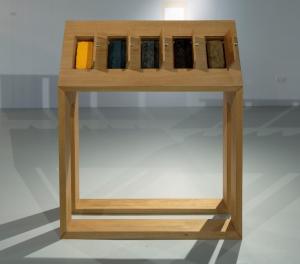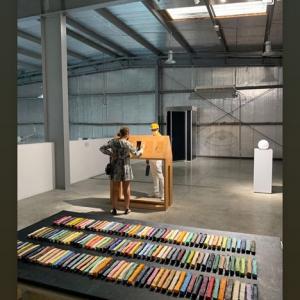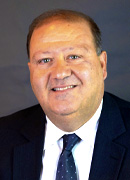
77 Soaps, glassbox, 9 openings, exhibited at the Maraya Art Center, 2020

10 Compartments, 10 soap blocks according to recipes

Through meticulous grinding, melting, and pouring, each soap bar turns into a unique object associated with personal memories and experiences with a bearing on personal cleaning and hygiene.

Two of Seidel’s most important artworks, Spectrum (2019) and Scent fields (2019), are currently among the prized possessions of Sheikh Zayed bin Sultan bin Khalifa Al Nahyan, a royal who is an aesthete and reputed for efforts to enrich the country’s cultu

While scent is part of life and culture in the UAE and across the Muslim world, Seidel maintains that odor-enhanced art is rather new to the place.
Tor Seidel uses scent in his artworks to attract attention and evoke memories about Muslim and Arab culture and history. This is a different approach in art. I don’t want to convince with a work, but rather invite communication and debate”
— Tor Seidel
SHARJAH, UNITED ARAB EMIRATES, October 16, 2024 /EINPresswire.com/ -- by Ifath Arwah
Tor Seidel, an artist at University of Sharjah’s College of Fine Arts and Design, is bringing olfactory perceptions to his artwork with installations whose ephemeral and invisible scent has become a source of odor attracting perfume-loving and smell-attuned Emiratis.
Seidel’s work revolves around creating artworks designed to attract attention by using scent to evoke memories, state of being, and emotions, adding a touch of olfaction to his art.
Seidel is aware that for millions of Muslims across the globe, fragrances are not merely something to smell and enjoy. They carry deep spiritual devotion and symbolic meaning.
Fresh and fragrant smell is a prerequisite for devout Muslims when performing their congressional prayer on Fridays. Scent is not only appreciated or just part of individual experiences and personal preferences. It is engrained in Muslim religion and culture.
It is no wonder to see the perfume market size skyrocketing in value in the United Arab Emirates (UAE) with an annual growth rate of 9.5%. It is predicted to grow to around $1.4 billion in 2032 from the current $643 million. Saudi Arabia’s perfume market is expected to hit $2.6 billion in the same period.
While scent is part of life and culture in the UAE and across the Muslim world, Seidel maintains that odor-enhanced art is rather new to the place. “One might ask why smell has been neglected in art for so long. Smell has a place, and that place is the object, a person, or a memory.”
Scent is a theme widely talked about in Arabic literature, particularly poetry . However, the realm of olfaction is rather new to art in the UAE and the larger Muslim and Arab world, though purchasing of perfumes is part of household shopping basket and fragrance boutiques and kiosks are most conspicuous in malls in Dubai and elsewhere in the country.
“In literature there are outstanding works on the subject of smell, but in art little attention is paid to smell” so far, explains Seidel, adding that people are used to looking at photographs and paintings. For a painting to have scent is rather unusual as most people’s understanding of art is firmly grounded in visual representation and perception, he adds.
Exhibited at the Maraya Art Center in Sharjah, Seidel’s odor installations are a new experience for the UAE art lovers. He points out that olfactory art usually attracts fewer visitors than expressive forms of art . However, he continues, scent has the power to unravel the world around us.
“When a visitor smells an object, it brings back memories and begins to tell a story. This is a different approach in art. I don’t want to convince with a work, but rather invite communication and debate,” Seidel says.
Seidel had his first olfactory art exhibition at the Maraya Art Center in 2019. Named “Soap/Scent Installation”, he featured in it a cabinet design reminiscent of a house. It contained ten compartments filled with soap blocks, each linked to specific recipes crafted from the participants’ sensory experiences, encouraging viewers to connect their olfactory experiences with the text excerpts displayed on top of the cabinet.
Two of Seidel’s most important artworks, Spectrum (2019) and Scent fields (2019), are currently among the prized possessions of Sheikh Zayed bin Sultan bin Khalifa Al Nahyan, a royal who is an aesthete and reputed for efforts to enrich the country’s cultural life.
In a notable exhibit dubbed “Aftermath” Seidel features 65 colored and scented soaps, which he arranges in a cabinet-like display at the Maraya Art Center. The soaps, which are presented behind a glass front and opaque paper, invite visitors to engage with the fragrances through nine openings.
In another installation called “Scent Fields,” Seidel infuses soap blocks with fragrances that mirror everyday olfactory experiences. Each compartment of the display evokes personal memories, connecting viewers to spaces, emotions, and stories that may have been long forgotten.
Another artwork named “Spectrum” showcases a transformative process involving 156 varieties of soap common to the Middle East and North Africa. Through meticulous grinding, melting, and pouring, each soap bar turns into a unique object associated with personal memories and experiences with a bearing on personal cleaning and hygiene.
Seidel’s vision extends beyond academia, with aspirations for collaboration with major perfume manufacturers. “Maybe we can do more, e.g., a perfume creation especially for Sharjah: Sharjah Beach scent, etc.,” he muses, envisioning commercial partnerships that could amplify the project's impact and reach.
Besides scent-enhanced installations, Seidel is working with his students to draw what he describes as “an olfactory map” of the city of Sharjah, the provincial capital of a UAE emirate of the same name, and the cosmopolitan city of Dubai. The UAE comprises seven semi-autonomous emirates or provinces of which Abu Dhabi is the capital.
Seidel and his students say they have marked on their “olfactory map” which odors the different localities of Sharjah are fond of. “Artists have been mapping color spaces for centuries,” he points out, reiterating that it is time for different regions to have their own scent maps.
He goes on, “This is an ambitious research project I am working on, and which may take 1.5 years to complete. I want to map the cities of Sharjah and Dubai in terms of their odor. This will be done by analyzing and materializing samples of the most average smells in different places at different times of the year.
This makes it possible to assign these (rarely changing) odors to locations. At the same time, there will be a series of photographs documenting these places . Finally, a map is created in which this data is inserted in the form of hyperlinks, photos, odor fields, text, etc.”
LEON YOUSIF BARKHO
University Of Sharjah971501654376email us here
Legal Disclaimer:
EIN Presswire provides this news content "as is" without warranty of any kind. We do not accept any responsibility or liability for the accuracy, content, images, videos, licenses, completeness, legality, or reliability of the information contained in this article. If you have any complaints or copyright issues related to this article, kindly contact the author above.
You just read:
News Provided By
October 16, 2024, 17:06 GMT
EIN Presswire's priority is author transparency. We do our best to weed out false and misleading content. The content above is the sole responsibility of the author who makes it available. If you have any complaints, kindly contact the author above.
Originally published at https://www.einpresswire.com/article/752265006/sharjah-university-artist-brings-olfactory-art-to-the-scent-attuned-people-of-united-arab-emirates






